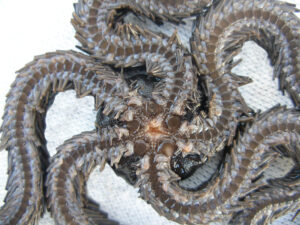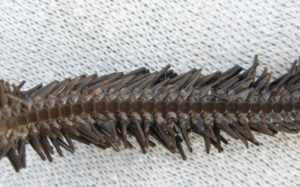Black Spiny Brittle Star, Ophiocoma aethiops



 Black Spiny Brittle Star, Ophiocoma aethiops. A of brittle star collected from a tidal pool in the greater Los Cabos area, Baja California Sur, January 2016. Wing-span: 35 cm (14 inches).
Black Spiny Brittle Star, Ophiocoma aethiops. A of brittle star collected from a tidal pool in the greater Los Cabos area, Baja California Sur, January 2016. Wing-span: 35 cm (14 inches).
Phylogeny: The Black Spiny Brittle Star, Ophiocoma aethiops (Lütken, 1859), is a member of the Ophiocomidae Family of Brittle Stars, that has two subfamilies, Ophiocominae and Ophiopsilinae that have four genera and one hundred twenty-seven species and one genera with thirty species, respectfully. The Ophiocoma Genus has seventy-seven known species. The Black Spiny Brittle Star is also known as the Giant Black Brittle Star and in Mexico as Estrella Bailarina.
Morphology: The Black Spiny Brittle Star is the largest brittle star found in the Eastern Pacific. They have a round central disk that has a scalloped margin and large oblong oral shields. They have maximum arm lengths of 43 cm (17 inches) and the maximum central disk diameter is 3.7 cm (1.5 inches). The arms are rounded, stout and slightly flattened with three or four alternating spines that are as long as the diameter of the arms and stretch out perpendicularly to the arm axis. The aboral or dorsal surface of the disk has a uniform light brown coloration and is covered with minute granules. The dorsal side is dark brown in color and the ventral side lighter brown.
Habitat & Distribution: The Black Spiny Brittle Star is common on rocky shores, under rocks in sand, or muddy areas of the lower and intertidal zones at depths up to 30 m (100 feet). They are found throughout the Sea of Cortez, along the west coast of Baja California Sur, and along the coast of the mainland south to Guatemala and are exceedingly abundant in some locations. They are scavengers and opportunistic feeders.
Reproduction: The reproduction of the Black Spiny Brittle Star is gonochoric and they are not sexually dimorphic. They are known to brood their juveniles within their respiratory structures.